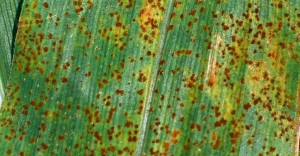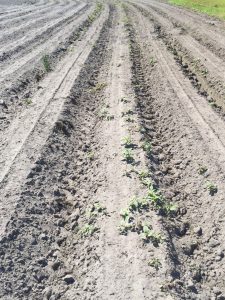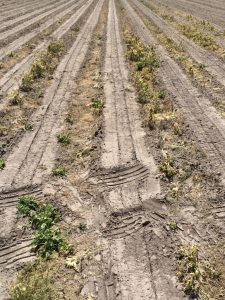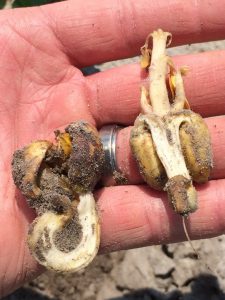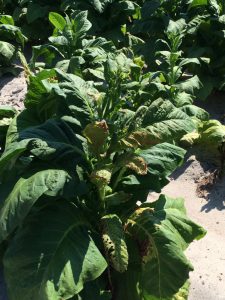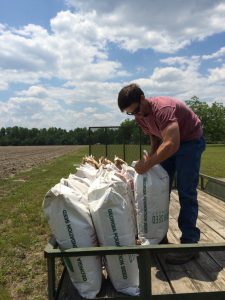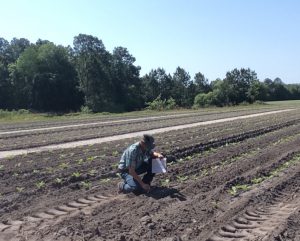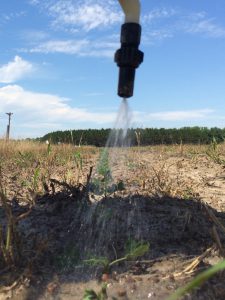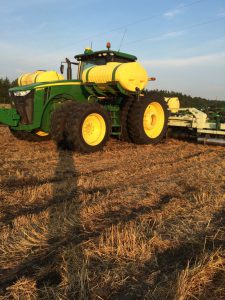Southern Corn Rust
Southern Corn rust is EARLY this year and has been found in Seminole, Wayne and Pierce Counties. Protecting corn approaching or beyond tassel with a fungicide is an important consideration. Once corn reaches the dough stage it is safe. Most likely, Southern Rust is in other area counties and possibly already in fields in Appling County.
For corn with good yield potential it is advised to apply a fungicide at the tassel stage. Southern Rust can significantly reduce yields if left untreated. Triazole fungicides (tebuconazole) and strobilurin fungicides (pyraclostrobin, azoxystrobin, and others) all have good activity against southern corn rust. Triazoles will have greater systemic activity and strobilurins will have a longer protective window.
Asian Soybean Rust
Asian soybean rust is in Florida and Alabama. That’s close enough proximity to Georgia that there is no doubt that our soybean crop will be affected this year. A fungicide is recommended between flowering and early pod development which is about the same time that Boron and Dimilin applications will be made.
Propiconazole and Phosphorous Acid Fungicides in Peanut
It’s getting about time for fungicide sprays to begin in peanut fields. Some earlier planted fields have already reached the starting date. You probably have heard by now that the European Union has questioned residue studies on propiconazole (active ingredient in products like Tilt and also a component of Artisan) specifically on peanut. This lead Syngenta Crop Protection to announce it will not sell Tilt/Bravo for the peanut market in 2016. Companies like Golden Peanut and Birdsong have notified growers not to use products containing propiconazole that will be sold to them. The European Union has also raised questions about residues with phosphite fungicides. Phosphite/phosphorous acid fungicides (like K-PHITE and ProPhyt) have been used in Georgia recently for management of Pythium pod rot, a disease that can be especially difficulty to control. Like peanuts treated with propiconazole, peanuts treated with phosphite-fungicides may also be rejected by the European Union. This may or may not affect you, but if it does here are recommendations from Dr. Kemerait:
- The only soilborne/white mold fungicide affected by the propiconazole issue has been Artisan. Artisan is a pre-mix of flutolanil and propiconazole. Growers can EASILY replace Artisan in their disease management program by selecting Convoy (flutolanil) and spiking with an appropriate leaf spot material. Use of Convoy maintains the efficacy of the flutolanil chemistry and adds flexibility in choice of leaf spot fungicide.
- Phosphite/phosphorous acid-fungicides have been the products of choice for management of Pythium pod rot. If growers are a not allowed to use a phosphite for control of this disease, azoxystrobin (Abound and generics) may offer some limited benefit.
- Loss of propiconaozle will affect leaf spot programs for many growers. Below are alternatives for use of Tilt/Bravo:
- Growers can replace Tilt/Bravo with Bravo (1 pt/A) + Alto (5.5 fl oz/A). The active ingredient in Alto is cyproconazole.
- Growers can replace Tilt/Bravo with chlorothalonil (1 pt/A) and Eminent (7.2 fl oz/A). the active ingredient in Eminent is tetraconazole; tetraconazole is not active against soilborne diseases.
- Growers can replace Tilt/Bravo with chlorothalonil (1 pt/A) and Topsin-M (5-10 fl oz/A). Note, a tank-mix of chlorothalonil + Topsin-M should not be used more than twice per season.
- Growers can replace two early-season applications of Tilt/Bravo with a single application of Priaxor (6 fl oz/A) at approximately 40 days after planting.
- Growers can cautiously replace Tilt/Bravo with Absolute (3.5 fl oz/A). Absolute, from Bayer CropScience, is a premix of trifloxystrobin and tebuconazole.
- Special notes on leaf spot control for 2016:
- Growers who apply Proline (5.7 fl oz/A) in-furrow at planting can expect some limited early-season benefit for leaf spot control as well. Though this WILL NOT replace a fungicide application for leaf spot control, it will help to a limited degree.
- Growers who apply Proline as an early-season white mold application (e.g., 21 days after planting) will not need to apply another leaf spot fungicide until at least 45 days after planting.
- Growers who plant varieties in 2016 that are VERY susceptible to leaf spot, e.g., ‘Georgia-13M’ and TUFRunner™ ‘511’ are advised when using strobilurin fungicides (like Abound and generic formulations of azoxystrobin) to tank-mix additional an additional fungicide for leaf spot control.
Don’t slack on weed control!
One thing we’ve constantly preached is NEVER PLANT INTO EMERGED PIGWEED. NEVER is pretty clear. That means NEVER. It doesn’t matter what variety or what herbicide you can use…..NEVER plant into pigweed. If you do, you will already be starting off behind and guaranteeing that you will have to hand pull weeds.

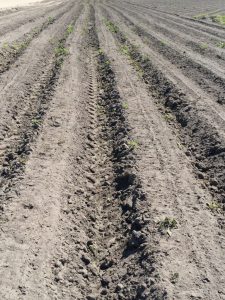
Where I see the most problems is on ripped and bedded land. The land is prepared and then left with no pre herbicide. Pigweed germinate between land prep and planting time. When the tractor and planter get to the field it knocks the top of the bed off, plants the seed and buries the pigweed. That doesn’t kill the pigweed.
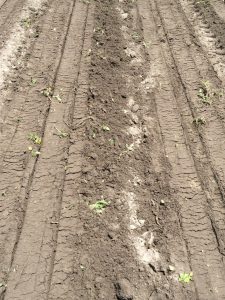
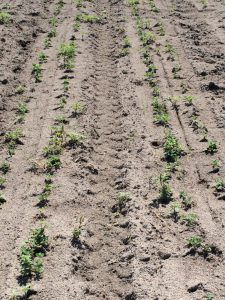
Don’t start off behind. Whether you are strip tilling or bedding land, you must start clean in a field BEFORE planting.
Liberty herbicide will be the backbone of our cotton herbicide program even with 2,4-D and Dicamba. We must protect Liberty. Spraying pigweed that are too large, not being timely and/or reducing rates will build resistance over time. This is what caused the resistance to glyphosate. Never reduce the labeled rate of Liberty and be timely when applying the herbicide. Remember: Yes, Liberty may kill a much larger pigweed than labeled, but at one time, so did glyphosate.
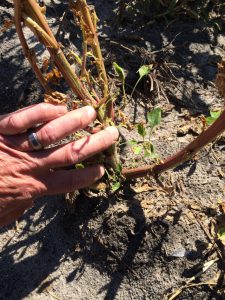
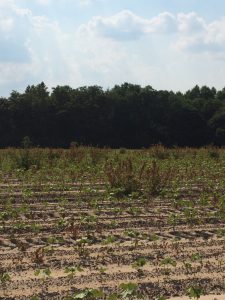
Peanut Germination
I’ve seen a few peanut fields with some strange germination happening. The field in the below pictures was planted May 25. The pictures were taken on June 14. Nearly 3 weeks after planting there’s still peanuts cracking and some that died before cracking. There’s a couple of possibilities for this. The most likely cause is weather related. Having enough moisture to get the seed to germinate at planting, followed by hot dry weather, followed by rain and then more hot dry weather can cause shock on the young seedling plants. Sometimes herbicides or seedling disease can also be an issue, but most likely we’re dealing with environmental stress.
Tomato Spotted Wilt Virus
This has been one of the worst years we’ve seen in a while for TSWV. Thrips pressure was really high mainly due to our warm winter. Thrips had plenty of weeds to feed on during the winter and the population continued to increase as spring and summer arrived. In my tobacco TSWV trial the worst time for infection was May 12-25. Tomatoes, peppers and in some fields peanuts have been hit hard with TSWV.
Upcoming Dates:
The GA/FL Tobacco Tour will make a stop in Appling County Wednesday June 15 at Jared and Danny Turner’s field off Hwy 121 at 11:45 am. We will be looking at a released variety research trial.
Soil Health Workshop June 21, 2016 8:30 am
The Georgia Conservation Tillage Alliance will be partnering with the Coastal Georgia RC&D Council on a soil health workshop and conservation tillage field day. This event will be held at the farm of Joey Norman at Glenville, Georgia. The afternoon session will be at the farm of Clayton Anderson, located in Register, Georgia. To sign up call Dianne Beasley at 912-459-2070
Southeast Georgia Pecan Field Day will be August 17
A New Tool
You can go to https://www.eddmaps.org/ipm/ and view what other Extension Agents and Specialists are reporting across Georgia. The EDDMapS IPM helps coordinate information from different sources to provide a clearer picture of current pest and disease activity, distribute that information and to help people make better pest management decisions.
Research Trials
Over the past couple of months I’ve been getting a lot of research trials planted. The last row crop trial was planted Friday June 3rd. If you would like to visit any of these trials please give me a call and I’ll be glad to show you.
2016 Research Trials:

